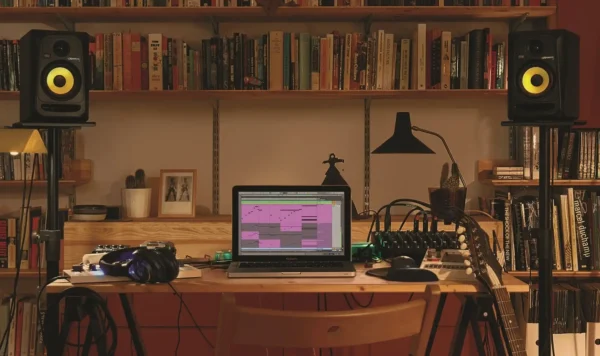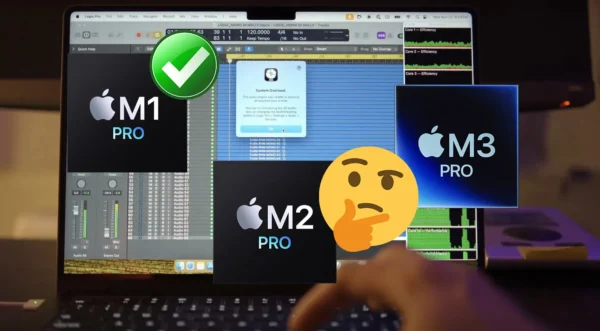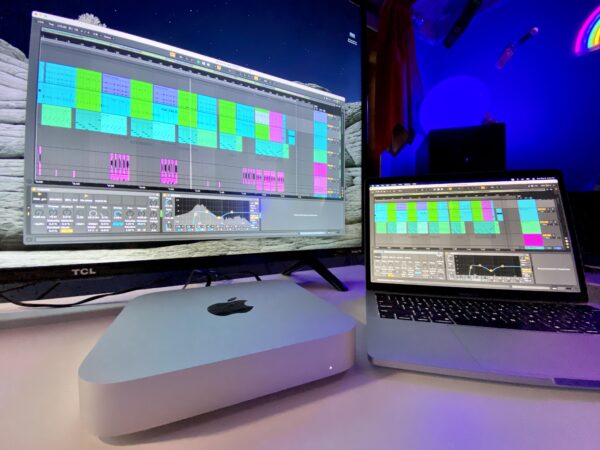Contents
- 1 The Best MacBook for Ableton: Powering Your Music Production
- 1.1 Why MacBooks Excel for Ableton Users
- 1.2 Key Factors in Choosing the Best MacBook for Ableton
- 1.3 Top Contenders for the Best MacBook for Ableton
- 1.4 Optimizing Your MacBook for Ableton
- 1.5 Maximizing Performance on Your MacBook for Ableton
- 1.6 Workflow Tips for Ableton on MacBook
- 1.7 Staying Mobile with Your MacBook and Ableton
- 1.8 Future-proofing Your Setup
- 1.9 Community and Resources
- 2 How to Download, Install and Setup Ableton in MacBook
The Best MacBook for Ableton: Powering Your Music Production

When it comes to music production, choosing the right hardware is crucial. For many producers, the best MacBook for Ableton is a top priority. Let’s dive into what makes a MacBook ideal for running Ableton and explore the options available.
Why MacBooks Excel for Ableton Users
MacBooks have long been favored by music producers, and for good reason. Their reliability, powerful processors, and seamless integration with audio interfaces make them an excellent choice for running Ableton. The best MacBook for Ableton will offer a perfect balance of performance and portability.
Key Factors in Choosing the Best MacBook for Ableton
Processing Power
The heart of any best MacBook for Ableton is its processor. Look for models with the latest Apple Silicon chips, such as the M1, M2, or their Pro and Max variants. These chips offer exceptional performance and energy efficiency, crucial for handling complex Ableton projects.
RAM Capacity
Running Ableton smoothly requires ample RAM. The best MacBook for Ableton should have at least 16GB of RAM, with 32GB or more being ideal for professional users working with large sample libraries and numerous plug-ins.
Storage Options
Fast, spacious storage is essential for the best MacBook for Ableton. Opt for models with at least 512GB SSD, with 1TB or more being preferable for storing large sound libraries and project files.
Top Contenders for the Best MacBook for Ableton
MacBook Pro 14-inch and 16-inch
These models are often considered the best MacBook for Ableton due to their powerful M1 Pro or M1 Max chips, high RAM options, and excellent displays. They offer the performance needed for professional-level music production.
MacBook Air M2
For those on a budget or prioritizing portability, the MacBook Air with M2 chip can be a solid choice. While not as powerful as the Pro models, it’s still capable of running Ableton effectively for many users.
Optimizing Your MacBook for Ableton

Once you’ve chosen the best MacBook for Ableton, consider these tips to maximize its performance:
- Keep your system and Ableton up to date
- Use an external audio interface for better sound quality and lower latency
- Utilize freeze and flatten features in Ableton to reduce CPU load
- Consider using an external monitor for a larger workspace
Maximizing Performance on Your MacBook for Ableton
Now that we’ve explored the options for the best MacBook for Ableton, let’s delve deeper into how you can optimize your setup for peak performance.
Fine-tuning Ableton Settings
Even with the best MacBook for Ableton, tweaking your software settings can significantly improve performance:
- Adjust the buffer size in Ableton’s preferences to balance between low latency and CPU usage
- Enable multicore support to utilize all available CPU cores
- Use the “Reduced Latency When Monitoring” option when recording
- Disable unused plug-ins and return tracks to save resources
External Hardware Considerations
While the best MacBook for Ableton packs a punch on its own, external hardware can enhance your setup:
- Audio Interface: Invest in a high-quality audio interface for improved sound and lower latency
- MIDI Controllers: Use MIDI keyboards or pad controllers for a more tactile experience
- External Drives: Store sample libraries on fast external SSDs to free up internal storage
Workflow Tips for Ableton on MacBook
Maximizing efficiency on your best MacBook for Ableton goes beyond hardware and settings:
- Use Ableton’s Session View for idea sketching and arrangement planning
- Utilize keyboard shortcuts to speed up your workflow
- Create and save default templates for quick project starts
- Group and color-code tracks for better organization
Staying Mobile with Your MacBook and Ableton
One of the advantages of choosing the best MacBook for Ableton is portability. Here’s how to make the most of it:
- Invest in a sturdy laptop case or backpack designed for musicians
- Use cloud storage services to back up and access your projects from anywhere
- Consider a portable MIDI controller for on-the-go music making
- Explore Ableton’s Link feature for jamming with other musicians wirelessly
Future-proofing Your Setup
The world of music production evolves rapidly. To ensure your best MacBook for Ableton stays relevant:
- Regularly update both macOS and Ableton Live
- Stay informed about new Ableton features and incorporate them into your workflow
- Consider gradually upgrading your plug-ins and virtual instruments
- Keep an eye on Apple’s hardware releases for potential future upgrades
Community and Resources
Joining the community of MacBook-using Ableton producers can provide valuable insights:
- Participate in online forums and social media groups dedicated to Ableton and MacBook users
- Attend local user groups or meetups to network and share knowledge
- Follow tutorials and courses specific to using Ableton on MacBooks
- Consider attending music production conferences or workshops
How to Download, Install and Setup Ableton in MacBook

Setting up Ableton on your MacBook is a straightforward process. This guide will walk you through downloading, installing, and setting up Ableton to get you started with music production on your MacBook.
Downloading Ableton
- Visit the official Ableton website (www.ableton.com).
- Click on the “Try Live for free” button to download the trial version, or go to the “Shop” section to purchase a license.
- Select the MacOS version of Ableton.
- The download will begin automatically. Wait for it to complete.
Installing Ableton on Your MacBook
- Locate the downloaded Ableton installer in your Downloads folder.
- Double-click the installer file to begin the installation process.
- Follow the on-screen instructions. You may need to drag the Ableton icon to your Applications folder.
- Once the installation is complete, you’ll find Ableton in your Applications folder.
Setting Up Ableton
Initial Setup
- Launch Ableton from your Applications folder.
- If you purchased a license, enter your activation code when prompted.
- Choose your preferred audio interface in the Audio preferences.
Configuring Audio Settings
- Go to Live > Preferences (or use CMD + ,).
- Click on the Audio tab.
- Select your audio interface from the Driver Type dropdown.
- Adjust the buffer size for optimal performance.
MIDI Setup
- In Preferences, click on the Link MIDI tab.
- Enable any MIDI controllers you want to use with Ableton.
Customizing Your Workspace
- Explore the various views in Ableton (Session and Arrangement).
- Familiarize yourself with the browser to access instruments, samples, and plugins.
- Consider setting up a default template for quick project starts.
Optimizing Ableton for Your MacBook
To ensure Ableton runs smoothly on your MacBook:
- Close unnecessary applications to free up system resources.
- Use the Freeze and Flatten features for CPU-intensive tracks.
- Consider using an external drive for sample libraries to improve performance.
Exploring Ableton’s Features
Now that you’ve set up Ableton on your MacBook, take time to explore its features:
- Experiment with built-in instruments and effects.
- Try recording audio and MIDI.
- Learn about warping and clip launching in Session View.
By following these steps, you’ll have Ableton downloaded, installed, and set up on your MacBook, ready for your music production journey. Remember to regularly check for updates to keep your Ableton software current and take advantage of new features and improvements
FAQs About the Best MacBook for Ableton

Q1: What’s the minimum RAM recommended for running Ableton on a MacBook? A: While Ableton can run on 8GB RAM, 16GB is recommended for smoother performance, especially when working with larger projects.
Q2: Are Intel-based MacBooks still good for Ableton? A: While Intel MacBooks can run Ableton, the newer Apple Silicon models offer better performance and energy efficiency.
Q3: Can I use a MacBook Air for professional music production with Ableton? A: Yes, the latest MacBook Air models, especially with the M2 chip, are capable of running Ableton for professional use, though they may struggle with extremely large or complex projects.
Q4: How important is the processor in choosing a MacBook for Ableton? A: The processor is crucial as it determines how many tracks, effects, and virtual instruments you can run simultaneously in Ableton.
Q5: Do I need a dedicated graphics card in my MacBook for Ableton? A: Ableton primarily relies on CPU power, so a dedicated graphics card isn’t necessary for most users.
Q6: How much storage do I need on my MacBook for Ableton? A: Aim for at least 512GB, but 1TB or more is better if you work with large sample libraries or store many projects.
Q7: Is it worth upgrading to a MacBook Pro from a MacBook Air for Ableton? A: If you work on complex projects or need maximum performance, the MacBook Pro’s additional power can be worth the upgrade.
Q8: Can I connect multiple MIDI devices to my MacBook for use with Ableton? A: Yes, MacBooks support multiple MIDI devices through USB ports or via a USB hub.
Q9: How often should I upgrade my MacBook for optimal Ableton performance? A: While it varies, many professionals upgrade every 3-5 years to keep up with software advancements and maintain peak performance.
Q10: Does screen size matter when choosing a MacBook for Ableton? A: While not critical, a larger screen can provide a more comfortable workspace. However, you can always connect an external monitor for more screen real estate.
Conclusion
Finding the best MacBook for Ableton depends on your specific needs and budget. Whether you opt for the top-of-the-line MacBook Pro or the more affordable MacBook Air, ensure it meets the minimum requirements for running Ableton smoothly. With the right MacBook, you’ll have a powerful tool to fuel your music production journey.





